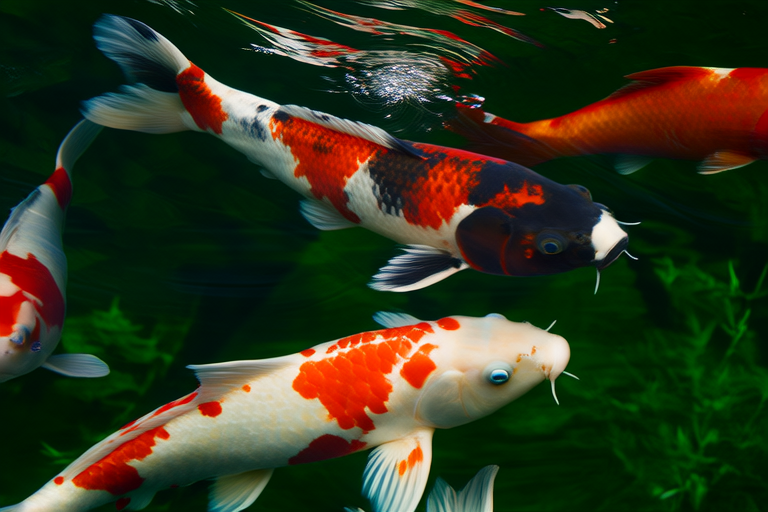Uncover the Secrets Behind Raising Healthy and Happy Koi
Koi fish are not just aquatic pets; they are vibrant, colorful companions that bring joy and tranquility to any pond or aquarium setting. However, raising healthy and happy koi requires more than just providing them with a tank or pond. It involves understanding their specific needs, maintaining optimal living conditions, and being proactive about their health. This article aims to guide both beginners and experienced koi keepers through the intricacies of raising these magnificent creatures.
Water Quality Maintenance: The Foundation of Koi Health
The single most critical factor in keeping koi healthy is maintaining excellent water quality. Koi thrive in environments that closely mimic their natural habitats. Therefore, it’s essential to monitor and manage several key parameters: temperature, pH levels, oxygen concentration, and ammonia, nitrite, and nitrate levels.
- Temperature: Koi are coldwater fish, typically comfortable between 15°C and 25°C (59°F and 77°F). Extreme temperatures can stress them, making them susceptible to diseases.
- pH Levels: The ideal pH range for koi is between 7.2 and 8.5. Regular testing and adjustments with appropriate products are necessary to maintain this balance.
- Oxygen Concentration: Koi require well-oxygenated water to breathe. Aerate your pond or tank adequately, especially during warmer months when oxygen levels tend to drop.
- Ammonia, Nitrite, and Nitrate Levels: High levels of these compounds can be toxic to koi. Establishing a robust biological filtration system helps break down these substances into less harmful nitrates.
Regular water changes, at least 10-20% weekly, also help maintain clean water and remove excess nutrients that could lead to algae blooms.
Diet Specifics: Nourishing Your Koi
A balanced diet is crucial for koi’s growth, coloration, and overall health. Their dietary needs change with the seasons. In spring and summer, feed them high-protein foods like pellets enriched with spirulina and krill to promote vibrant colors and robust growth. During autumn and winter, switch to low-protein, easily digestible feeds to prevent digestive issues caused by slower metabolism.
Feed koi only what they can consume within five minutes. Overfeeding leads to waste accumulation, which deteriorates water quality. Additionally, avoid feeding koi immediately after water changes as this can cause stress.
Vitamins and minerals play a vital role in their health. Incorporate supplements into their diet if needed, but always consult a veterinarian or expert before introducing new elements.
Suitable Habitat Setup: Creating a Natural Environment
Creating an environment that mimics koi’s natural habitat is essential for their happiness and well-being. Start by ensuring adequate space; each adult koi requires approximately 100 gallons of water. Incorporate plenty of plants, rocks, and caves to provide hiding spots and reduce stress.
Shading your pond or tank is also important, as direct sunlight promotes algae growth. Use floating plants, such as water hyacinths or duckweed, to provide shade and absorb excess nutrients from the water.
Incorporate gentle water movement to simulate stream-like currents. This not only improves oxygen circulation but also encourages natural swimming patterns. Avoid strong water flow, as it can stress koi.
Finally, consider adding beneficial bacteria to your pond. These microorganisms help break down organic matter, contributing to cleaner water and a healthier ecosystem.
Common Health Issues Prevention: Keeping Your Koi Safe
Despite your best efforts, koi may still face health challenges. Common issues include fin rot, bacterial infections, parasites, and swim bladder disorders. Preventing these problems begins with maintaining pristine water conditions and avoiding overcrowding.
Quarantine any new additions to your pond for at least two weeks to prevent introducing diseases. Regularly inspect your koi for signs of illness, such as lethargy, abnormal swimming behavior, or lesions. Early detection and treatment significantly improve recovery rates.
Consult a veterinarian specializing in aquatic animals for diagnosis and treatment options. They can prescribe appropriate medications and offer guidance tailored to your koi’s specific needs.
Interactive Ways to Ensure Their Happiness: Bonding with Your Koi
Interacting with your koi can enhance their well-being and strengthen your bond with them. Feeding time offers an opportunity for gentle interaction. Koi quickly learn to recognize their caretakers and anticipate feeding times, responding positively to familiar faces.
Another way to engage with your koi is through gentle hand feeding. Gradually introduce this practice by offering food from your hand at the edge of the pond or tank. Over time, some koi will become comfortable enough to eat directly from your palm.
Creating a stimulating environment also contributes to their happiness. Introduce toys or structures that encourage exploration and play. Floating balls or tunnels can provide entertainment and mental stimulation.
Lastly, observe your koi regularly. Understanding their behaviors and preferences allows you to meet their needs effectively. Pay attention to social dynamics within the group and address any conflicts promptly.
Conclusion: A Rewarding Journey
Raising healthy and happy koi is a rewarding endeavor that combines science, art, and dedication. By focusing on water quality maintenance, providing a balanced diet, setting up a suitable habitat, preventing common health issues, and fostering positive interactions, you create an environment where your koi can flourish.
Remember, koi are sensitive creatures with unique requirements. Stay informed about advancements in koi care and be prepared to adapt your practices as needed. With patience, commitment, and love, you’ll enjoy many years of companionship with these beautiful fish.
